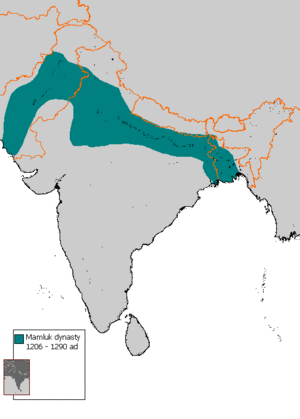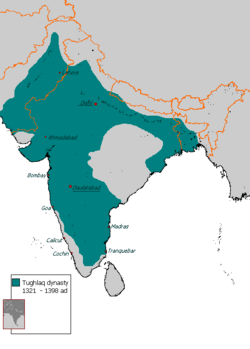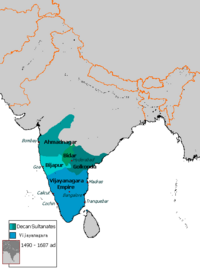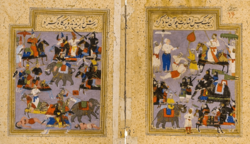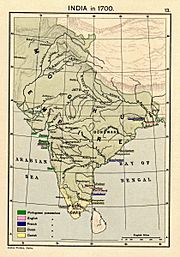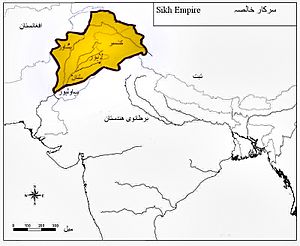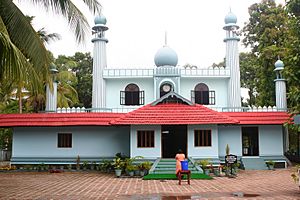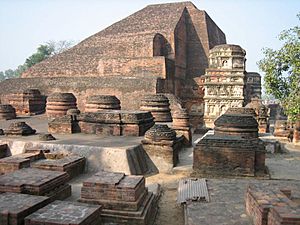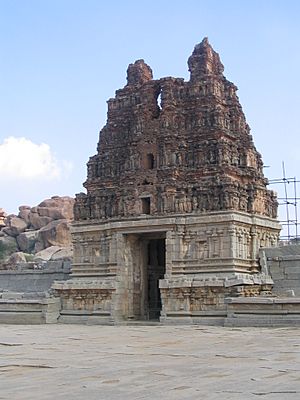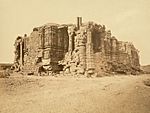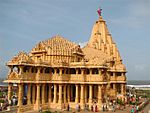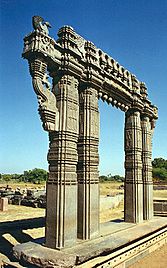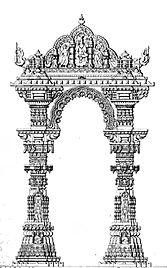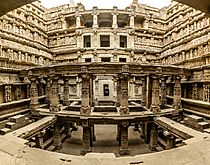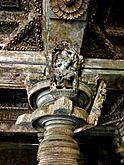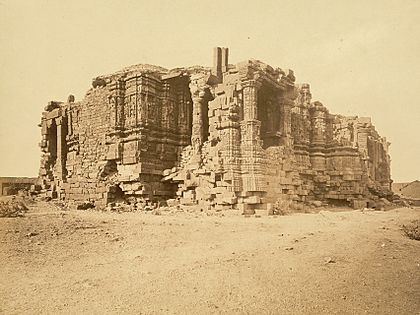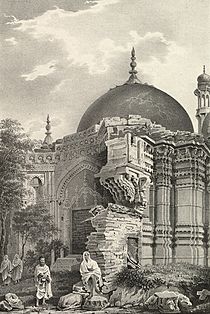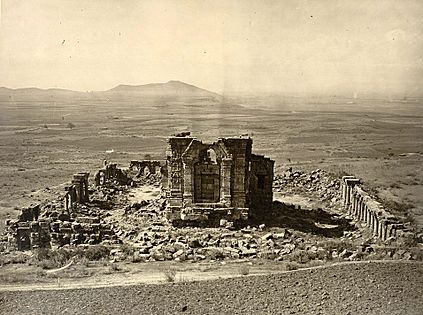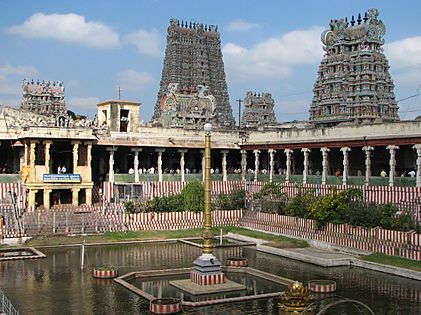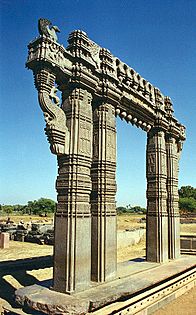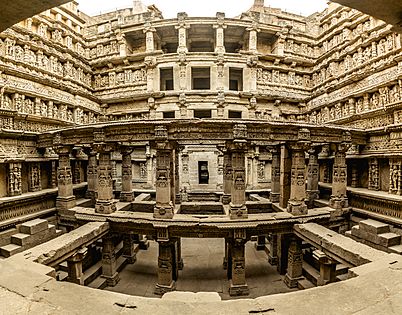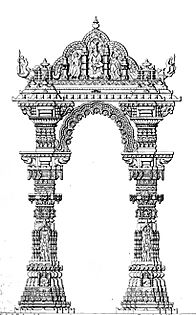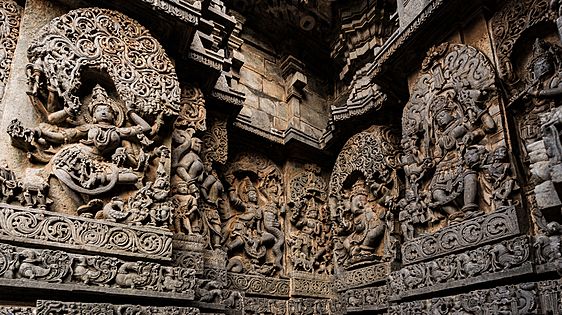Muslim conquests in the Indian subcontinent facts for kids
The Muslim conquests in the Indian subcontinent mostly happened between the 13th and 18th centuries. Before this, some Muslim groups had already arrived in what is now Pakistan. This included the Umayyad campaigns in the 700s, which were met with strong resistance from the Rajputs.
Mahmud of Ghazni, the first Sultan, invaded and took over large parts of Punjab and Gujarat in the 1000s.
After Lahore was captured and the Ghaznavid rule ended, the Ghurid ruler Muhammad of Ghor started Muslim rule in India. In 1206, Bakhtiyar Khalji led the Muslim conquest of Bengal. This was the furthest east Islam had spread at that time. The Ghurid Empire soon became the Delhi Sultanate, led by Qutb ud-Din Aibak. He founded the Mamluk dynasty. With the Delhi Sultanate in charge, Islam spread across most of the Indian subcontinent.
In the 1300s, the Khalji dynasty under Alauddin Khalji expanded Muslim rule south to Gujarat, Rajasthan, and the Deccan. The next dynasty, the Tughlaq dynasty, even reached Tamil Nadu for a short time. The Delhi Sultanate started to break apart, especially after Timur invaded in 1398. This led to many smaller Muslim kingdoms appearing across India, like the Gujarat Sultanate and the powerful Bengal Sultanate. However, some of these areas were later taken back by Hindu kingdoms like the Vijayanagara Empire and Rajput states.
The Sur Empire, led by Sher Shah Suri, controlled much of northern India for a while. After this, the Mughal Empire took over almost all of India. The Mughals were one of the three big "gunpowder empires" of that time.
Emperor Akbar made the Mughal Empire much larger. Even though they were a military empire, the Mughals did not always treat everyone badly. Especially under Akbar the great, who believed in religious tolerance, the empire became multicultural. Non-Muslims were included in the government and army. The Mughal Empire was strongest in the late 1600s, during the rule of Emperor Aurangzeb. During his time, Islamic Sharia law was fully established.
The Mughal Empire quickly declined after Aurangzeb died in 1707. This was because his successors were not strong leaders.
Other reasons for the decline included costly wars with the Rajputs and the Marathas. In 1739, Nader Shah from Persia attacked, showing how weak the Mughal Empire had become. This allowed many local states, like the Maratha Empire and Sikh Empire, to become independent. The Maratha Empire then became the most powerful force in India.
Later, the British East India Company took control of much of India after battles like the Battle of Plassey and the Anglo-Maratha Wars. By the end of the 1800s, most of India was under British rule, known as the British Raj.
The history of Muslim conquests in India is very complex and still debated today.
Contents
Early Muslim Presence (700s to 900s)
First Contacts and Raids
Islam in South Asia first appeared in communities along Arab trade routes in places like Sindh, Bengal, Gujarat, and Kerala. The first Arab attacks on India happened around 636 AD. These were naval raids on ports like Thane (near Mumbai) and Debal. These early attacks were likely to get wealth or stop pirates, not to conquer India.
After the Muslim conquest of Persia, connections between Sindh and Islam grew through early Muslim missions.
The Indian Frontier and Early Battles
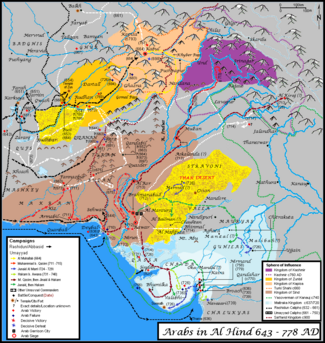
Desert areas (Registan Desert and Thar Desert) Zunbils Turk Shahis Kingdom of Kashmir Kingdom of Sindh (c. 632– 711 CE)
then, Caliphal province of Sind (712-854 CE) Maitraka Kingdom (c.475–c.776 CE)
Kingdoms in modern-day Afghanistan and Pakistan, like Kapisa-Gandhara and Sindh, were seen by Arabs as "The Frontier of Al Hind." The first major clash between an Indian ruler and Arabs happened in 643 AD in Sistan. Arab forces reached the Indus River in 644 AD, but the Caliph Umar did not allow them to cross into India.
Later, under the Umayyad Caliphate, Muslim expansion continued. In 664 AD, an Arab general named Muhallib reached areas between Multan and Kabul. However, local rulers like Turki Shah and Zunbil fought back strongly, blocking routes into India for many years. This made it hard for Arabs to fully conquer these areas.
Conquest of Sindh and Multan
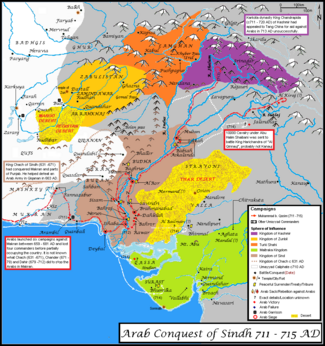
Desert areas (Registan Desert and Thar Desert) Zunbils Turk Shahis Kingdom of Kashmir Kingdom of Sindh (c. 632– 712 AD) Maitraka Kingdom (c.475–c.776 AD) Umayyad Caliphate (c.710 AD)
Pirates from areas like Kutch and Debal kidnapped Muslim women, which led to a major conflict with Raja Dahir of Sindh. After two failed attempts, the powerful governor Al Hajjaj sent a large army led by his nephew, Muhammad bin Qasim, to Sindh.
Muhammad bin Qasim started his campaign in 710 AD. He marched along the coast, conquering towns like Fannazbur and Armabil. His army, with powerful catapults, then captured Debal. They moved north along the Indus River, taking towns like Nerun and Sadusan peacefully. After a major battle where Raja Dahir was killed, the Arabs captured Rawer, Brahmanabad, Alor, and finally Multan. By 713 AD, they reached the foothills of Kashmir. However, Muhammad bin Qasim was removed from power in 715 AD, and Arab control in Sindh weakened for a while.
Later, in 723 AD, Junaid b. Abd Al Rahman Al Marri became governor of Sindh. He recaptured Debal and secured Sindh. He also attacked Hindu kingdoms in Rajasthan, Gujarat, and Madhya Pradesh. However, Arab control over these new areas was lost due to internal conflicts.
In 733 AD, Al Hakam b. Awana Al Kalbi founded a new city, Al Mahfuza, near Brahmanabad. He tried to regain the lost territories and was successful in some areas. However, his forces were defeated in 739 AD by the Chalukya Empire in the Deccan. Arab rule then mostly stayed west of the Thar Desert.
Decline of Caliphate Control
When the Abbasid Revolution overthrew the Umayyads in 750 AD, Sindh became independent. Local dynasties emerged, and by 871 AD, five independent areas existed. Ismaili missionaries found many followers in Multan, making it a center for their branch of Islam.
Later, new Turkic and Central Asian dynasties like the Saffarid dynasty and Samanid Dynasty took over. Their continuous raids into northwestern India weakened Indian kingdoms and helped establish Islam deeper into India.
Mahmud of Ghazni became Sultan in 998 AD. He launched seventeen expeditions into India in the early 1000s. In 1001 AD, he defeated Raja Jayapala of the Hindu Shahi Dynasty in the Battle of Peshawar. He made Peshawar a base for his forces.
Al Biruni, a scholar, wrote about the destruction caused by Mahmud of Ghazni. He said Mahmud "utterly ruined the prosperity of the country" and made Hindus "like atoms of dust scattered in all directions." This led Hindus to dislike Muslims strongly.
Mahmud's conquests were first aimed at the Ismaili Fatimids of Multan. After that, he focused on looting Indian temples and monasteries. By 1027 AD, Mahmud controlled parts of North India. His rule in northwestern India lasted over 175 years. Lahore became a very important city during this time.
Mahmud's empire stretched from Kurdistan to Punjab. Although his raids went across Northern and Western India, only Punjab came under his permanent rule. Other areas like Kashmir and Gujarat remained under local Indian rulers.
Ghurid Empire
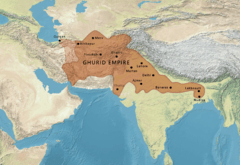
Mu'izz al-Din, also known as Muhammad Ghori, was a conqueror from Ghor in modern Afghanistan. In 1186, he conquered Lahore, ending the Ghaznavid empire. His early campaigns in India were against the Qarmatians of Multan.
In 1191, he invaded the territory of Prithviraj III of Ajmer but was defeated at the First Battle of Tarain. The next year, Mu'izz al-Din returned with a huge army and won the Second Battle of Tarain. Prithviraj was killed, and Mu'izz al-Din advanced to Delhi. Within a year, he controlled North-Western Rajasthan and the Northern Ganges-Yamuna Doab region. Delhi became the capital of his Indian provinces.
Mu'izz al-Din returned to Ghazni to deal with threats from other Turkic empires. His armies continued to advance through Northern India, even raiding as far as Bengal. In 1206, he was assassinated while returning to Ghazni.
Third Phase: Delhi Sultanate (1200s to 1500s)
The Delhi Sultanate Begins
Muhammad Ghori's successors started the first dynasty of the Delhi Sultanate. The Mamluk Dynasty took control in 1211. "Mamluk" means "slave," referring to the Turkic slave soldiers who became rulers. The area controlled by Muslim rulers in Delhi grew quickly.
Five different dynasties ruled from Delhi: the Mamluk (1206–1290), the Khalji (1290–1320), the Tughlaq (1320–1414), the Sayyid (1414–51), and the Lodhi (1451–1526). The Khalji and Tughlaq dynasties made the most conquests, reaching deep into southern India.
Khalji Invasions
The Khalji dynasty brought new Indo-Muslim nobles to power. These new leaders, many of whom were Indian Muslims, helped the Sultanate expand rapidly. Generals like Ayn al-Mulk Multani conquered the Paramara kingdom of Malwa. Nusrat Khan Jalesari attacked and took over Gujarat, looting its cities and temples, including the famous Somnath temple. It was here that Nusrat Khan captured Malik Kafur, who later became a famous military general. Malik Kafur and Khusraw Khan conquered southern India, taking much wealth.
Tughlaq Invasions
The Tughlaqs took Delhi with the help of the Khokhar tribes. They attacked and looted Malwa, Gujarat, and many other regions across India. The Tughlaqs even moved their second capital to Daulatabad in southern India. They wanted Muslim people from Delhi to settle there and help spread Islam in the Deccan region.
During the Delhi Sultanate, the Vijayanagara Empire in southern India strongly resisted Muslim attempts to control their region.
The Delhi Sultans based their laws on the Quran and sharia (Islamic law). They allowed non-Muslims to practice their religions if they paid a special tax called jizya. They ruled from cities, and new towns grew around military camps and trading posts.
The Sultanate helped protect India from the Mongol invasions from Central Asia in the 1200s. This period also saw a mix of Indian and Muslim cultures in architecture, music, literature, and religion. The Urdu language, a mix of Hindi, Persian, Turkish, and Arabic, developed during this time.
The Sultanate was greatly weakened when Timur sacked Delhi in 1398. It briefly recovered under the Lodi Dynasty but was finally conquered by Babur in 1526, who then founded the Mughal Empire.
Timur's Invasion
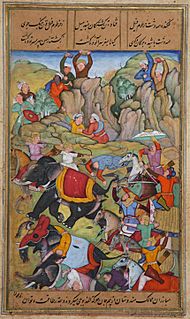
Timur, also known as Tamerlane, was a powerful warlord from the 1300s. He had conquered much of western and central Asia. In 1398, he invaded northern India, claiming the Muslim Delhi Sultanate was too tolerant of its Hindu subjects. However, his real goal was to gain the wealth of Delhi.
Timur crossed the Indus River in September 1398. His soldiers killed many civilians on their way to Delhi. He faced some resistance, but he continued his march.
Timur's army easily defeated the Sultan's army on December 17, 1398. Timur entered Delhi, and the city was looted and destroyed. Before the battle, Timur reportedly killed over 100,000 captives.
Timur wrote about his invasions in his memoirs. He left Delhi in early 1399, taking huge amounts of treasure. It is said that 90 captured elephants were used to carry precious stones, which were used to build a mosque in Samarkand.
Regional Sultanates
After the Delhi Sultanate weakened, many regional kingdoms became powerful. These included Kashmir, Bengal, Gujarat, and the Bahmanis. It was often easier for people to convert to Islam under these regional rulers.
Deccan Sultanates
The Deccan Sultanates were five Muslim kingdoms in South India: Bijapur, Golkonda, Ahmadnagar, Bidar, and Berar. They became independent when the Bahmani Sultanate broke apart.
The ruling families of these sultanates came from different backgrounds, including Iranian, Georgian, and even Hindu families.
Fourth Phase: Mughal Empire (1500s to 1700s)
The Mughal Empire Rises
In the early 1500s, India was divided among many rulers. Meanwhile, in Central Asia, Babur of the Timurid dynasty was pushed south. He first went to Kabul and then into India. The dynasty he founded lasted for over two centuries.
-
The Mughal Emperor Akbar shoots the Rajput warrior Jaimal during the Siege of Chittorgarh in 1567.
-
The Mughal Army commanded by Akbar attack members of the Sannyasa during the Battle of Thanesar.
-
The Mughal Emperor Akbar fights Pehlwani with his Hindu general Raja Man Singh I of Jaipur.
Babur's Rule
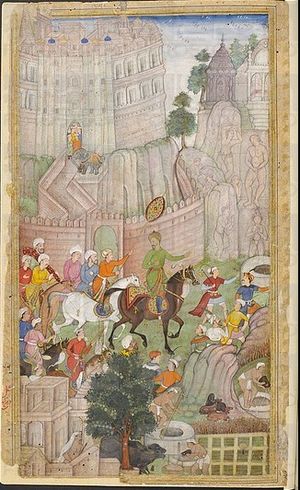
Babur, a descendant of both Genghis Khan and Timur, was a strong military leader. He focused on controlling Northwestern India. In 1526, he defeated the last Lodhi Sultan in the First battle of Panipat. Babur then convinced his Central Asian followers to stay in India and defeated other rivals like the Rajputs. He died in 1530. The Mughal Empire became one of the largest centralized states before modern times.
Babur's great-grandson, Shah Jahan (1628–1658), built the famous Taj Mahal. Two other important Mughal emperors were Akbar (1556–1605) and Aurangzeb (1658–1707). Both expanded the empire and were good administrators. However, Akbar was known for his religious tolerance, while Aurangzeb was a very religious Muslim who favored stricter Islamic rules.
Aurangzeb's Reign
Aurangzeb's rule (1658-1707) saw strong religious policies. He expanded the Mughal Empire by conquering much of southern India through long, difficult campaigns. He also brought back the jizya, a tax on non-Muslims, which his great-grandfather Akbar had stopped.
Aurangzeb ordered the destruction of temples when conquering new lands or putting down rebellions. In 1669, he ordered governors to destroy schools and temples of "infidels." The exact number of temples destroyed is debated, but he likely built more temples than he destroyed.
The Mughal Empire began to weaken after Aurangzeb's death. Power struggles and costly wars led to its decline.
Durrani Empire
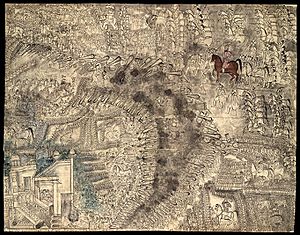
Ahmed Shah Abdali, a Pashtun leader, began conquests in South Asia in 1747. He built one of the largest Muslim empires of the 1700s. His biggest victory was over the powerful Maratha Empire in the Third Battle of Panipat in 1761. His empire stretched from the Indus River to eastern Punjab. However, his empire began to fall apart before his death in 1772 due to revolts by the Sikhs.
Decline of Muslim Rule
Maratha Empire
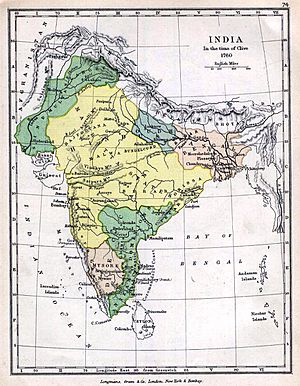
The most important power to emerge after the Mughals was the Maratha Confederacy (1674–1818). The Marathas played a big role in ending Mughal rule in India. Their long wars weakened the Mughal Empire. At its peak, the Maratha Empire stretched from southern India to the Afghan border in the north. In 1771, a Maratha general recaptured Delhi and made the Mughal emperor a puppet ruler. The British Empire later took control of much of India after defeating the Marathas in 1818.
Sikh Empire
In northwestern India, the Sikhs became a powerful force. By 1801, Ranjit Singh captured Lahore and freed North West India from Afghan control. The Sikh Empire gained major victories over the Durrani Empire, such as in the Battle of Attock in 1813. In 1818, they captured Multan, and in 1819, they conquered Kashmir from the Afghans.
Impact on India and Islam
The history of Muslim conquests in India is complex and still debated. Some historians describe it as a very violent period, while others say such views are exaggerated.
Conversion to Islam
There are different ideas about why people converted to Islam in India:
- Some Muslims are descendants of people who moved from Iran or Arabia.
- Many converted for practical reasons, like social status or to avoid taxes.
- Some converted because of the influence of Sunni Sufi saints, experiencing a true change of heart.
- Some Buddhists and lower-caste Hindus converted to escape the strict Hindu caste system.
- It could be a mix of force at first, followed by genuine acceptance.
- It was a long process of cultural mixing and integration into the larger Muslim world.
Historians like Will Durant called the Islamic invasions "the bloodiest story in history." Others, like Audrey Truschke and Romila Thapar, argue that these claims are overblown.
Hindus who converted to Islam were sometimes still treated differently. They were seen as a lower caste by some Muslim groups. Some argue that Indian religions faced persecution, with massacres, temple attacks, and forced conversions.
However, others point out that large Muslim communities exist in South India, Sri Lanka, and Southeast Asia, far from the main Muslim empires. This suggests that conversion was not always by force. Muslim rulers were not just raiders; many stayed to create new kingdoms. Their policies varied, and some were popular.
Many temples were destroyed by Muslim conquerors. Historian Richard M. Eaton lists 80 temples destroyed but notes that Hindu and Buddhist kings also destroyed temples of rivals in medieval India. He also points out that the Delhi Sultanate sometimes protected and repaired temples. Attacks on temples decreased under the Mughal Empire.
Population estimates suggest that India's population actually increased between 1000 and 1500 AD, showing that widespread massacres leading to population decline are unlikely.
Trade Expansion
Islam greatly impacted trade. Early Muslim contact with India was to protect trade routes. Many Arabs settled in Indian ports, forming Muslim communities. Some Hindu kings even hired Muslims as soldiers.
The rise of Islamic law created a common trading system from Morocco to Indonesia. This helped trade grow significantly. Northern India found new trade opportunities. Muslim rulers encouraged trade by removing taxes and building roads, like the Grand Trunk Road built by Sher Shah Suri. This road connected Chittagong to Kabul and parts of it are still used today.
Cultural Influence
Muslim rule had a huge impact on Indian culture, affecting language, clothing, food, art, architecture, and social customs. The languages of Muslim invaders mixed with local languages, leading to the creation of Urdu, which uses the Arabic script.
Muslim rule led to more cities and urban cultures in India. The common legal system for trade also changed the economy, shifting focus from farming to trade.
New technologies and crafts were introduced. For example, ceramic tiles came from Iraq and Iran. Indian artisans learned new skills like book-binding and paper-making. Many cities became known for specific crafts, like pottery or carpets.
Indian scientific and mathematical ideas, like the Hindu numerals, spread to the rest of the world through Muslim scholars. Muslim rulers also supported arts and sciences.
Islamic and Mughal architecture, like the Taj Mahal and Jama Masjid, are famous in India. However, some ancient Indian buildings were destroyed or converted into Islamic structures.
Migration of Hindus
Some groups of Hindus, including Rajputs, moved into what is now Nepal before the fall of Chittor in 1303 due to Muslim invasions. This migration is supported by historical records. The Hindu immigrants were welcomed by local rulers and mixed into the local societies.
Religious Policies and Iconoclasm
General Effects
Muslim rule in parts of India lasted for centuries. While there were periods of violence, there were also times of peaceful Hindu-Muslim relations. The Indian population grew during this period. No groups were expelled based on religion, nor were attempts made to wipe out a specific religion.
According to Romila Thapar, Muslim rule grouped all Indians, regardless of caste, as "Hindus." This led to a feeling among some higher-caste Hindus that their religion had suffered severe persecution. However, Thapar notes that religious persecution existed in India even before Muslims arrived. She also points out that while Muslim rulers destroyed temples, some also made donations to Hindu groups.
During Islamic rule, there was some state-sponsored persecution against Hindus, but it was usually not widespread and often aimed at religious monuments. Emperor Aurangzeb was known for being very strict towards non-Muslims, but communal riots between Hindus and Muslims were rare.
Destruction of Religious Buildings
Destroying Hindu idols and temples was seen as an attack on Hindu religious practices. Muslim texts from this period often justify such acts based on their dislike for idols. However, historians note that these texts might exaggerate. Temples were often symbols of power, so destroying them could be a political act.
Destroying sacred temples was not unique to Muslim rulers. Some Hindu kings also took idols from rival temples as symbols of victory. However, Hindu kings usually treated these idols with respect and placed them in new temples. Muslim texts, in contrast, describe the intentional destruction and defilement of idols.
Effect on Hindu Learning
The destruction of temples and schools, and the killing of learned monks, led to a decline in Hindu education in some areas. Science and philosophy faced setbacks due to less royal support. However, traditional village schools continued, and local languages based on Sanskrit thrived. Many ancient texts were translated into these languages.
Iconoclasm During Conquests
Sindh (700s)
Records from the Chach Nama describe the destruction of temples during Muhammad bin Qasim's campaign in 712 AD. For example, temples in Debal, Nairun, and Aror were demolished and turned into mosques.
Delhi Sultanate (1200s-1500s)
Historian Richard Eaton lists 37 instances of Hindu temples being destroyed or damaged by Delhi Sultans between 1234 and 1518. However, he also notes that Hindu and Buddhist kings destroyed temples of rivals. There were also cases where Delhi Sultans protected or repaired temples. For example, Sultan Muhammad bin Tughluq repaired a Siva temple.
Often, broken pieces of destroyed temples were used to build mosques. For instance, the Qutb complex in Delhi was built from stones of 27 demolished Hindu and Jain temples. Muhammad bin Bakhtiyar Khalji destroyed Buddhist and Hindu libraries at Nalanda and Odantapuri Universities in 1193 AD.
The destruction of temples and defacement of idols began in 1193-1194 under Ghuri. Under later sultans, it spread to more regions. Sometimes, reconstruction of damaged temples was forbidden unless a special tax was paid. Firoz Shah Tughlaq even wrote about destroying temples and building mosques instead.
Nalanda University
In 1193, the Nalanda University complex, a major Buddhist learning center, was destroyed by Afghan Muslims under Bakhtiyar Khalji. This event is seen as a key moment in the decline of Buddhism in India. He also burned Nalanda's library and other monasteries.
Martand Sun Temple
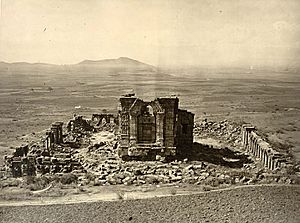
The Martand Sun Temple, built in the 700s, was completely destroyed by the Muslim ruler Sikandar Butshikan in the early 1400s. This demolition took a year. Sikandar is known for trying to convert Hindus in Kashmir to Islam and destroying many old temples.
Vijayanagara City
The city of Vijayanagara was a flourishing capital between the 1300s and 1500s. It often fought with the Deccan Sultanates. In 1565, the empire's armies were defeated by an alliance of the Sultanates. The victorious armies then destroyed and looted the city for several months. The capital was never rebuilt.
Somnath Temple
Around 1024 AD, Mahmud of Ghazni raided Gujarat and looted the Somnath temple. The temple was rebuilt. In 1299, Alauddin Khalji's army again sacked the Somnath temple. In 1665, Mughal emperor Aurangzeb ordered its destruction, and again in 1702.
- Iconoclasm during the Muslim conquests in the Indian subcontinent
-
The Somnath temple in Gujarat was repeatedly destroyed by Islamic armies and rebuilt by Hindus. It was destroyed by Delhi Sultanate's army in 1299 AD. The present temple was reconstructed in Chaulukya style of Hindu temple architecture and completed in May 1951.
-
The Kashi Vishwanath Temple was repeatedly destroyed by Islamic invaders such as Qutb ud-Din Aibak.
-
The armies of Delhi Sultanate led by Muslim Commander Malik Kafur plundered the Meenakshi Temple and looted it of its valuables.
-
Kakatiya Kala Thoranam (Warangal Gate) built by the Kakatiya dynasty in ruins; one of the many temple complexes destroyed by the Delhi Sultanate.
-
Rani ki vav is a stepwell, built by the Chaulukya dynasty, located in Patan; the city was sacked by Sultan of Delhi Qutb ud-Din Aybak between 1200 and 1210, and it was destroyed by Alauddin Khalji in 1298.
-
Artistic rendition of the Kirtistambh at Rudra Mahalaya Temple. The temple was destroyed by Alauddin Khalji.
See also
 In Spanish: Conquistas musulmanas en el subcontinente indio para niños
In Spanish: Conquistas musulmanas en el subcontinente indio para niños
- Outline of South Asian history
- History of Afghanistan
- History of India
- History of Pakistan
- History of Bangladesh
- History of Islam
- Spread of Islam
- Islam and other religions
- Islam in Asia
- Muslim kingdoms in the Indian subcontinent
- Ghazwa-e-Hind
- List of early Hindu–Muslim military conflicts in the Indian subcontinent
- Muslim conquests of Afghanistan
- Decline of Buddhism in the Indian subcontinent
- Mughal–Maratha Wars (1680–1707)
- Ahom–Mughal conflicts (1615–1682)
- Aniconism
- Aniconism in Islam
- Iconoclasm
- Persecution of Hindus
- Persecution of Buddhists
- Conversion of non-Islamic places of worship into mosques



